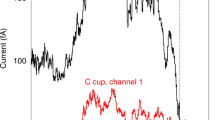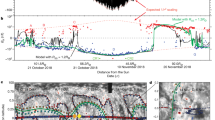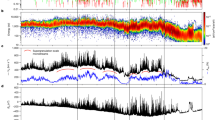Abstract
The solar wind blows outward from the Sun and forms a bubble of solar material in the interstellar medium. The termination shock occurs where the solar wind changes from being supersonic (with respect to the surrounding interstellar medium) to being subsonic. The shock was crossed by Voyager 1 at a heliocentric radius of 94 au (1 au is the Earth–Sun distance) in December 2004 (refs 1–3). The Voyager 2 plasma experiment observed a decrease in solar wind speed commencing on about 9 June 2007, which culminated in several crossings of the termination shock between 30 August and 1 September 2007 (refs 4–7). Since then, Voyager 2 has remained in the heliosheath, the region of shocked solar wind. Here we report observations of plasma at and near the termination shock and in the heliosheath. The heliosphere is asymmetric, pushed inward in the Voyager 2 direction relative to the Voyager 1 direction. The termination shock is a weak, quasi-perpendicular shock that heats the thermal plasma very little. An unexpected finding is that the flow is still supersonic with respect to the thermal ions downstream of the termination shock. Most of the solar wind energy is transferred to the pickup ions or other energetic particles both upstream of and at the termination shock.
This is a preview of subscription content, access via your institution
Access options
Subscribe to this journal
Receive 51 print issues and online access
$199.00 per year
only $3.90 per issue
Buy this article
- Purchase on Springer Link
- Instant access to full article PDF
Prices may be subject to local taxes which are calculated during checkout





Similar content being viewed by others
References
Decker, R. B. et al. Voyager 1 in the foreshock, termination shock, and heliosheath. Science 309, 2020–2024 (2005)
Burlaga, L. F. et al. Crossing the termination shock into the heliosheath: magnetic fields. Science 309, 2027–2029 (2005)
Stone, E. C. et al. Voyager 1 explores the termination shock region and the heliosheath beyond. Science 309, 2017–2020 (2005)
Burlaga, L. F. et al. Magnetic fields at the solar wind termination shock. Nature 10.1038/nature07029 (this issue)
Decker, R. B. et al. Mediation of the solar wind termination shock by non-thermal ions. Nature 10.1038/nature07030 (this issue)
Gurnett, D. A. & Kurth, W. S. Intense plasma waves at and near the solar wind termination shock. Nature 10.1038/nature07023 (this issue)
Stone, E. C. et al. An asymmetric solar wind termination shock. Nature 10.1038/nature07022 (this issue)
Bridge, H. S. et al. The plasma experiment on the 1977 Voyager mission. Space Sci. Rev. 21, 259–287 (1977)
Opher, M., Stone, E. C. & Liewer, P. C. The effects of a local interstellar magnetic field on Voyager 1 and 2 observations. Astrophys. J. 640, L71–L74 (2006)
Pogorelov, N. V., Zank, G. P. & Ogino, T. Three-dimensional features of the outer heliosphere due to coupling between the interstellar and interplanetary magnetic fields. II. The presence of neutral hydrogen atoms. Astrophys. J. 644, 1299–1316 (2006)
Lallement, R. et al. Deflection of the interstellar neutral hydrogen flow across the heliospheric interface. Science 307, 1447–1449 (2005)
Izmodenov, V., Malama, Y. G. & Ruderman, M. Solar cycle influence on the interaction of the solar wind with Local Interstellar Cloud. Astron. Astrophys. 429, 1069–1080 (2005)
Gurnett, D. A. & Kurth, W. S. Electron plasma oscillations upstream of the solar wind termination shock. Science 309, 2025–2027 (2005)
Opher, M., Stone, E. C. & Gombosi, T. I. The orientation of the local interstellar magnetic field. Science 316, 875–878 (2007)
Jokipii, J. R., Giacalone, J. & Kota, J. Transverse streaming anisotropies of charged particles accelerated at the solar wind termination shock. Astrophys. J. 611, L141–L144 (2004)
Gloeckler, G., Fisk, L. A. & Lanzerotti, L. J. Acceleration of solar wind and pickup ions by shocks, in Connecting Sun and Heliosphere (Proc. Solar Wind 11/SOHO 16 Conf.) (eds Fleck, B., Zurbuchen, T. H. & Lacoste, H.) 107–112 (ESA, Noordwijk, 2005)
Zank, G., Pauls, H., Cairns, I. & Webb, G. Interstellar pickup ions and quasi-perpendicular shocks: Implications for the termination shock and interplanetary shocks. J. Geophys. Res. 101, 457–477 (1996)
Lipatov, A. S. & Zank, G. P. Pickup ion acceleration at low-β p perpendicular shocks. Phys. Rev. Lett. 82, 3609–3612 (1999)
Giacalone, J. & Burgess, D. Hybrid simulations of the interaction of a current sheet with the termination shock. Eos 88 (Fall meeting), abstr. SH12B-05 (2007)
Pogorelov, N. V., Stone, E. C., Florinski, V. & Zank, G. P. Termination shock asymmetries as seen by the Voyager spacecraft: The role of the interstellar magnetic field and neutral hydrogen. Astrophys. J. 668, 611–624 (2007)
Wang, C., Richardson, J. D. & Paularena, K. I. Predicted Voyager observations of the Bastille Day 2000 coronal mass ejection. J. Geophys. Res. 106, 13007–13013 (2001)
Berdichevsky, D. B., Szabo, A., Lepping, R., Viñas, A. & Mariani, F. Interplanetary fast shocks and associated drivers observed through the 23rd solar minimum by Wind over its first 2.5 years. J. Geophys. Res. 105, 27289–27314 (2000)
Vinas, A. F. & Scudder, J. D. Fast and optimal solution to the ‘Rankine-Hugoniot problem’. J. Geophys. Res. 91, 39–58 (1986)
Acknowledgements
The work at MIT is supported by NASA. C.W. is grateful for support from NNSFC. Magnetic field data are shown courtesy of the Voyager magnetometer team (principle investigator N. Ness). We thank G. Gordon, Jr and L. Finck for development of and assistance with the plasma analysis.
Author Contributions J.D.R. analysed the plasma data and wrote the paper. J.C.K. performed the calculations for and write-up of the shock parameters. C.W. calculated the termination shock motion. J.W.B. and A.J.L. assisted with design of the instrument and manuscript preparation.
Author information
Authors and Affiliations
Corresponding author
Additional information
Data from the Voyager 2 plasma experiment are available at http://web.mit.edu/space/www/voyager.html.
Rights and permissions
About this article
Cite this article
Richardson, J., Kasper, J., Wang, C. et al. Cool heliosheath plasma and deceleration of the upstream solar wind at the termination shock. Nature 454, 63–66 (2008). https://doi.org/10.1038/nature07024
Received:
Accepted:
Issue Date:
DOI: https://doi.org/10.1038/nature07024
This article is cited by
-
Future Exploration of the Outer Heliosphere and Very Local Interstellar Medium by Interstellar Probe
Space Science Reviews (2023)
-
Oblique and rippled heliosphere structures from the Interstellar Boundary Explorer
Nature Astronomy (2022)
-
In Situ Observations of Interstellar Pickup Ions from 1 au to the Outer Heliosphere
Space Science Reviews (2022)
-
Interstellar Neutrals, Pickup Ions, and Energetic Neutral Atoms Throughout the Heliosphere: Present Theory and Modeling Overview
Space Science Reviews (2022)
-
Recent Developments in Particle Acceleration at Shocks: Theory and Observations
Space Science Reviews (2022)
Comments
By submitting a comment you agree to abide by our Terms and Community Guidelines. If you find something abusive or that does not comply with our terms or guidelines please flag it as inappropriate.



